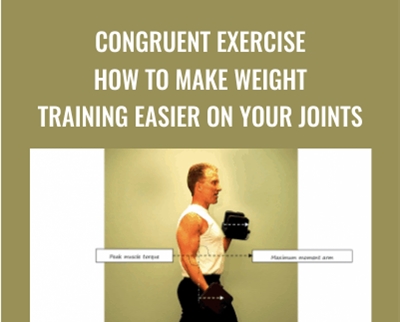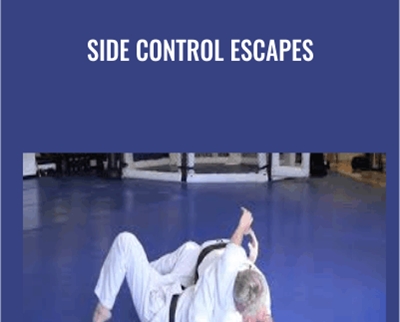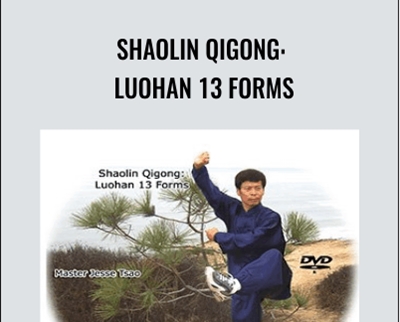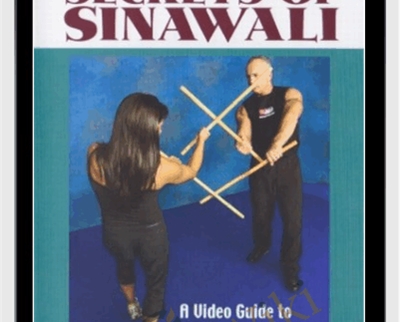Congruent Exercise. How To Make Weight Training Easier on Your Joints – Bill DeSimone
Original price was: $100.00.$21.00Current price is: $21.00.
Congruent Exercise. How To Make Weight Training Easier on Your Joints – Bill DeSimone Download. You would think that with all the exercise options availabl…
Salepage link: At HERE. Archive: https://www.hituni.com/guest-blogs/congruent-exercise-make-weight-training-easier-joints/#.Xt21B0UzbIV
Congruent Exercise offers a unique, biomechanics-based approach to weight training. By putting safe muscle and joint function first, and then designing the exercises to fit that, the goal is to get all the benefits of weight training, without any injuries or chronic conditions, over years of training.
You would think that with all the exercise options available today, it should go without saying that what you do to get in shape actually has some relationship with proper muscle and joint function.
You would think that for all the avenues of exercise information – the websites, magazines, certifications, academic departments, etc. – that someone would regularly compare a biomechanics textbook to what human joints and muscles are subject to in exercise, and identify any questionable practices.
You would think that for as many times as we see the words “functional” and “biomechanically-correct” and “safe and effective”, there would never be any injuries or problems resulting from exercise, and that everyone indulging in it would have a stronger, pain-free, injury-free body as a result.
You might think that, but it’s not true.
There have been several high-profile injuries to top athletes in the weight room, all of which were easily preventable, and worse, easily predictable, to anyone with even a passing familiarity with biomechanics.
But it’s not just catastrophic events happening to high level athletes, who might be willing to accept more risk in hope of a substantial reward. Much of what we find in commercial exercise subjects the joints and muscles to strains that simply cannot be met, over time, by human anatomy; and no, it’s not a question of “working through” or “getting used to it”.
Many of the joint movements and loading patterns found in classic, free-weight bodybuilding, so-called “functional training”, and machine designs are guilty of this.
And while not as dramatic as the athletes’ injuries, over time, this strain can contribute to a long list of chronic conditions, such as back and knee pain, impingements, tendinitis, bursitis, ruptures, tears. Yes, people, who don’t lift weights also get these conditions, but the wear and tear of a lifetime that leads to those conditions is already there. Why add to it with poorly designed exercises?
Of course, the long-term detriment will only be there if you stick with it.
- How many people drop out of exercise because their results don’t measure up?
- How many people get frustrated, because they don’t continue to improve, as they’ve been led to believe?
So, they read another website and try another scheme, or they go the supplement and ergogenic aids route, which can lead to all sorts of confusion and frustration and all that entails.
Much of today’s exercise scene is based on performance.
- competing with others in a group workout,
- setting a personal record in a lift,
- finishing a machine circuit in a faster time.
And you certainly can get in shape this way, but frequently at a physical cost. This might be a perfectly valid approach to a sports competition, for which you’ll make some short-term sacrifice for the larger goal of winning the event. While there certainly is a value to peaking for a specific event, by definition, it’s not training that can last.
The trend, of course, has been away from exercises and towards real world movements.
“Real world movements”, like flipping tires and slamming sledgehammers and heaving heavy weights. Which may be someone’s real world, but not mine.
I suggest there is a huge chunk of the population, who currently don’t, but would obviously benefit greatly from regular exercise, who are completely turned off by the “trendy stuff”. People:
- Who don’t want to feel shown up by others working out at the same time.
- Who look at the extremes and realize, there’s no way I can do that without getting hurt.
- Who don’t really care about trends, or about “exceeding their limits” and getting injured in the process.
Those people are ready for the HITuni approach; of doing a distinct exercise, with a distinct purpose, in a controlled way. Of it not interfering with their week, either from too much time spent on it or from dealing with an injury. Of getting what they can from the workout, safely, and getting back to their life.
Today, amid the continuing, overwhelming clutter of the fitness “industry”—the online influencers, the boot camps, the infomercials, the alphabet soup of certifications, the (remaining) glossy print magazines, and the like, HITuni may be the only provider of formal education in safe, brief, effective, exercise-based weight training.
I’m more interested in the long haul.
I’m looking at weight training as a regular activity, every week, for a lifetime, to get whatever benefits you can for as long as you can. Aching shoulders, backs, and knees, not to mention more serious injuries, tend to discourage that. And since many of those aches, pains, and injuries come from the disconnect between Biomechanics and Exercise, it’s a pretty direct fix.
You may be surprised that many of the joint motions you’re used to seeing in conventional exercise, contradict safe joint motions as described in biomechanics textbooks.
Part of that comes from compromised sports, dance, and martial arts movements working their way into exercise.
Part of it comes from the visceral appeal of exercise (“no pain, no gain”) and associating “feel” with benefit, even if what you’re feeling is strain.
While popular exercise concerns itself with bigger biceps and ripped abdomens, academic biomechanics are working on joint replacements and prosthetics. (Where ARE their priorities?)
This leaves a huge gap, where basic biomechanics could be applied to exercises, taking some of the material from academia and dropping it into the gym where people might be able to use it earlier in life.
Congruent Exercise is intended to do just that.
It is my pleasure and an honor to offer this version of Congruent Exercise to the students and clients of HITuni.
I’ve been using weights myself for almost 40 years (I should be HUGE). I started as an exerciser myself in the 1970s, and a personal trainer in 1983. I’ve been certified by two of the major organizations, and I train clients in my own studio. I’ve competed… well, maybe “participated” is more accurate… I’ve participated in bodybuilding, triathlon, inline skating, martial arts, softball, and the usual sports.
And boy, have I inflicted some damage on myself! Nothing particularly life-threatening, a back ache here, a ruptured biceps there, a ruptured triceps also there, a chronic sore shoulder, but enough to get my attention. So, a few years ago, I put aside my old muscle magazines and trade paperbacks and firmly held beliefs, and dove into texts on biomechanics and anatomy and kinesiology and simple machines. Most of those texts aren’t written with working out in mind; they are more like reference texts.
I eventually settled on a pattern of starting with a basic conventional exercise, looking at the relevant anatomy and movements, and then modifying the exercise to match textbook muscle-and joint- function. I tried the exercises on myself, and where appropriate, on clients, until I arrived at the set of exercises illustrated in Congruent Exercise. I’ve used the work of Mike Mentzer and Ellington Darden as a base, and added my interpretation of biomechanics and rehabilitation material. I began to present the material, first in a manual called Moment Arm Exercise, then at in-services, conferences, and most recently on You Tube, hopefully refining the presentation, so that the concepts to follow are clear and accurate enough for you to use in the gym tomorrow.
Congruent Exercise was first available in print in 2012, a year later on Kindle, and now as a pdf through HITuni.
Each version is primarily the same with some minor differences. The print version has black and white photos to demonstrate the exercises. The Kindle replaces those with a link to YouTube video of the same exercise. This version is a pdf of the print version with color photos instead of black and white. The content remains the same; how you view it is slightly different. If, after looking at this pdf, you prefer the print or Kindle.
A few disclaimers
First, I’m a trainer.
I’m not a physiologist, or a doctor, or a mechanical engineer, or a biomedical engineer, or a kinesiologist, or physical therapist… you get the drift. I’m trying to apply what appears to be proper muscle and joint function, as laid out in those texts, to getting another human being to lift a heavy thing for health purposes.
So, I may sacrifice the precision of a reference text in labeling or describing, in order to relate what to do in the gym now. Hopefully, we gain in clarity what I give up in precision. If you need the exact nomenclature, well, that’s what bibliographies are for.
Second, I’m not the Reality-Show-Trainer-Star-type.
I’m not afraid of, or opposed to, hard physical work as part of getting in shape, but I do prefer to avoid unintended consequences. I’ve heard people say that ‘injuries are the price you pay to get in great shape’.
That’s silly and self-defeating. The price you pay is the time you spend doing it, that you could be doing something else. Setting yourself up for a back or shoulder injury (or worse), now or in the future, is a heavy price to pay, especially when the information to avoid it is easily available now, and when the connection between the risk and reward is speculative at best.
Finally, to be clear on the context: weight training has undeniable benefits.
It can give shape and strength to our muscles, and make the physical parts of our day easier. It can help prevent injury, and keep us mobile and functional as we age. It can help our mood and self-esteem, and dozens of other measures.
It can also crush spines, throats, and jaws; tear rotator cuffs, rupture biceps, quadriceps, and other muscles; and combined with everything else in life, contribute to chronic joint problems. And it can be frustrating and lead to a number of dead ends.
Both the pros and cons are true; fortunately, it’s not an either/or situation. You can get all the benefits of weight training, without the risk and frustration, by applying the appropriate joint movements, postures, moment arms, i.e. biomechanics , to your exercises. And you’ll be able to apply this anywhere, whether you are surrounded by the most current, high tech, selectorized machines, or sewer plates on a rusty bar, or doing chin- ups on a tree, because the one constant is your body and biomechanics.
To bring this back to HITuni: after Congruent Exercise, the next significant body of work I wrote on the topic is the Functional Training and HIT course. This elaborates on the discussion of functional training and biomechanics started in Congruent Exercise, and features truly excellent video work by Ioanna and Simon.
Thank you for your interest in sensible, exercise-based exercise. All the best with your training.
Here's an overview of the prominent keywords and a list of famous authors:
Business and Sales: Explore business strategies, sales skills, entrepreneurship, and brand-building from authors like Joe Wicks, Jillian Michaels, and Tony Horton.
Sports and Fitness: Enhance athleticism, improve health and fitness with guidance from experts like Shaun T, Kayla Itsines, and Yoga with Adriene.
Personal Development: Develop communication skills, time management, creative thinking, and enhance self-awareness from authors like Gretchen Rubin, Simon Sinek, and Marie Kondo.
Technology and Coding: Learn about artificial intelligence, data analytics, programming, and blockchain technology from thought leaders like Neil deGrasse Tyson, Amy Cuddy, and Malcolm Gladwell.
Lifestyle and Wellness: Discover courses on holistic health, yoga, and healthy living from authors like Elizabeth Gilbert, Bill Nye, and Tracy Anderson.
Art and Creativity: Explore the world of art, creativity, and painting with guidance from renowned artists like Bob Ross and others.
All the courses on WSOlib are led by top authors and experts in their respective fields. Rest assured that the knowledge and skills you acquire are reliable and highly applicable.
Specification: Congruent Exercise. How To Make Weight Training Easier on Your Joints – Bill DeSimone
|
User Reviews
Only logged in customers who have purchased this product may leave a review.

Original price was: $100.00.$21.00Current price is: $21.00.












There are no reviews yet.